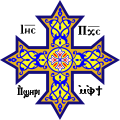
Saint Memnon the Wonderworker was alive during the second century A.D. [1] [2] He was a hegumen of an Egyptian monastery. His feast day is April 28 (Eastern Orthodox liturgics).
In the Egyptian desert he practised religious asceticism. [3]
He is said to have performed a number of miracles. Some of his miracles include causing a spring to gush forth, destroying a plague of locusts, curing illnesses and saving boats from destruction. [2] [4]
